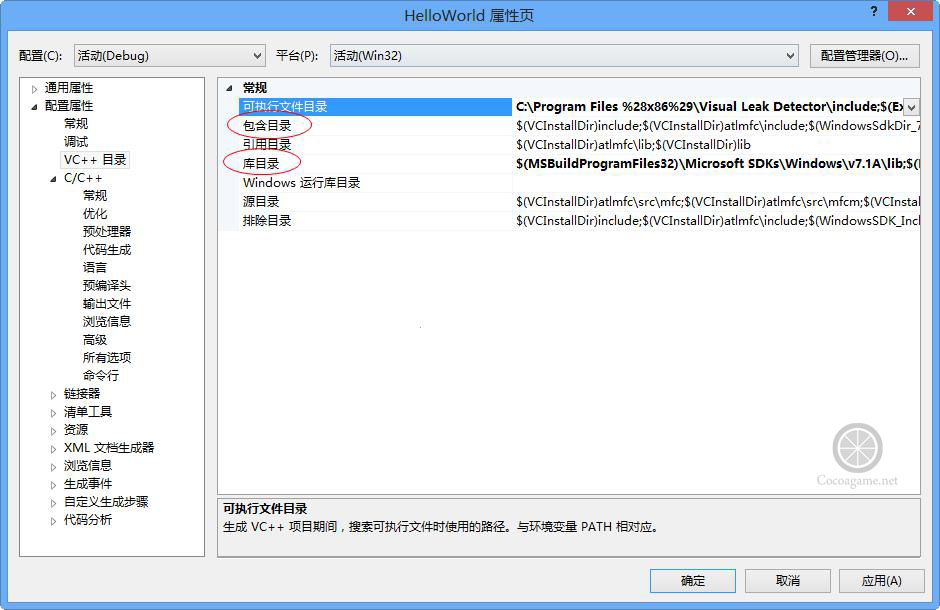那么在Windows下有什么好的内存泄漏检测工具呢?微软提供Visual Studio开发工具本身没有什么太好的内存泄漏检测功能,我们可以使用第三方工具Visual Leak Detector(以下简称vld)。
vld工具是VC++环境下一款小巧易用、免费开源的内存泄漏检测工具,vld可以显示导致内存泄漏的完整内存分配调用堆栈。vld的检测报告能够对每个内存泄漏点提供完整的堆栈跟踪,并且包含其源文件及行号信息。
安装过程是,先在到地址http://vld.codeplex.com/下载vld安装文件,然后进行安装,安装过程中需要安装程序会配置环境变量。我们需要记住安装目录。
安装完成后打开要检测的Visual Studio工程,我们需要在工程中配置:vld头文件目录和vld库目录。
选中游戏工程,打开菜单“项目”→ “属性”弹出工程属性对话框,如图所示,选择“配置属性”→“VC++目录” →“常规”,在右边的“包含目录”中添加C:\Program Files (x86)\Visual Leak Detector\include,其中C:\Program Files (x86)\Visual Leak Detector是我的vld安装目录。“库目录”中添加C:\Program Files (x86)\Visual Leak Detector\lib\Win32,注意配置目之间需要用分号分隔开。
配置完成之后点击确定按钮关闭对话框,然后我们需要在程序代码中引入头文件#include <vld.h>,但是这个头文件在哪里引入比较好?如果是普通的一个VC++工程在哪里引入都无所谓,但是Cocos2d-x的工程就不同了,我们需要考虑跨平台,#include <vld.h>代码不宜添加到Classes目录下的h或cpp文件中,这个目录下的文件是要在其它平台编译运行的,而#include <vld.h>只是在Windrows平台才有效。我们可以在Win32目录(见图)下的main.cpp或main.h文件引入头文件。这些文件是与Win32平台有关的,不同平台移植的时候不需要。
如果在main.cpp中引入代码如下:
- #include "main.h"
- #include "AppDelegate.h"
- #include "cocos2d.h"
- #include <vld.h>
- USING_NS_CC;
- int APIENTRY _tWinMain(HINSTANCE hInstance,
- HINSTANCE hPrevInstance,
- LPTSTR lpCmdLine,
- int nCmdShow)
- {
- UNREFERENCED_PARAMETER(hPrevInstance);
- UNREFERENCED_PARAMETER(lpCmdLine);
- // create the application instance
- AppDelegate app;
- return Application::getInstance()->run();
- }
引入之后,就测试一下了,我们来人为制造一个内存泄漏,与20.1.1一节一样在HelloWorldScene.cpp中修改代码:
- bool HelloWorld::init()
- {
- if ( !Layer::init() )
- {
- return false;
- }
- __String *s = new __String();
- log("%s",s->getCString());
- … …
- return true;
- }
运行工程,需要注意的是在程序运行过程中vld是没有堆栈输出的,但是日志会有输出vld的安装信息,日志信息如下:
Visual Leak Detector Version 2.4RC2 installed.
Ready for GLSL
Ready for OpenGL 2.0
… …
从日志中可以看到vld是否安装成功,以及安装的版本。要想看到vld检测报告需要退出程序后,才会在日志中输出信息。使用Cocos2d-x会输出很多日志信息,信息如下:
---------- Block 526166 at 0x0821FA80: 84 bytes ----------
Leak Hash: 0x780B2033, Count: 1, Total 84 bytes
Call Stack (TID 4660):
... ...
---------- Block 526214 at 0x08224378: 8 bytes ----------
Leak Hash: 0xE1DC1852, Count: 1, Total 8 bytes
Call Stack (TID 4660):
... ...
Data:
63 6F 63 6F 73 32 64 20 61 75 74 6F 72 65 6C 65 cocos2d. autorele
61 73 65 20 70 6F 6F 6C 00 CD CD CD CD CD CD CD ase.pool ........
Visual Leak Detector detected 33 memory leaks (2892 bytes).
Largest number used: 3204961 bytes.
Total allocations: 69022415 bytes.
Visual Leak Detector is now exiting.
其中一个Block表示一个内存泄漏点,在众多Block如果能够找到关于我们自己类的日志信息呢?我们可以查找关键字“helloworldscene.cpp”,这就可以定位到HelloWorld场景中的内存泄漏的Block了,我们找到如下日志信息:
---------- Block 1153 at 0x01533C70: 48 bytes ----------
Leak Hash: 0x5545A5ED, Count: 1, Total 48 bytes
Call Stack (TID 2088):
f:\dd\vctools\crt_bld\self_x86\crt\src\new.cpp (57): MSVCR110D.dll!operator new
d:\helloworld\classes\helloworldscene.cpp (33): HelloWorld.exe!HelloWorld::init + 0x7 bytes
d:\helloworld\classes\helloworldscene.h (37): HelloWorld.exe!HelloWorld::create + 0xB1 bytes
d:\helloworld\classes\helloworldscene.cpp (12): HelloWorld.exe!HelloWorld::createScene + 0x5 bytes
d:\helloworld\classes\appdelegate.cpp (30): HelloWorld.exe!AppDelegate::applicationDidFinishLaunching + 0x5 bytes
d:\helloworld\cocos2d\cocos\2d\platform\win32\ccapplication.cpp (74): HelloWorld.exe!cocos2d::Application::run + 0xF bytes
d:\helloworld\proj.win32\main.cpp (19): HelloWorld.exe!wWinMain + 0xC bytes
f:\dd\vctools\crt_bld\self_x86\crt\src\crtexe.c (528): HelloWorld.exe!__tmainCRTStartup + 0x15 bytes
f:\dd\vctools\crt_bld\self_x86\crt\src\crtexe.c (377): HelloWorld.exe!wWinMainCRTStartup
0x7563850D (File and line number not available): KERNEL32.DLL!BaseThreadInitThunk + 0xE bytes
0x77B7BF39 (File and line number not available): ntdll.dll!RtlInitializeExceptionChain + 0x85 bytes
0x77B7BF0C (File and line number not available): ntdll.dll!RtlInitializeExceptionChain + 0x58 bytes
Data:
1C 34 07 01 01 00 00 00 27 00 00 00 00 00 00 00 .4...... '.......
2C 34 07 01 A0 77 01 03 00 CD CD CD CD CD CD CD ,4...w.. ........
CD CD CD CD CD CD CD CD 00 00 00 00 0F 00 00 00 ........ ........
从这个日志中能看到内存泄漏点,从日志的堆栈中找到我们自己编写的类,点击那一行打开代码窗口,定位内存泄漏点代码,如图所示。
定位内存泄漏点
找到哪一个有可能有内存泄漏,解决就不是问题了。


